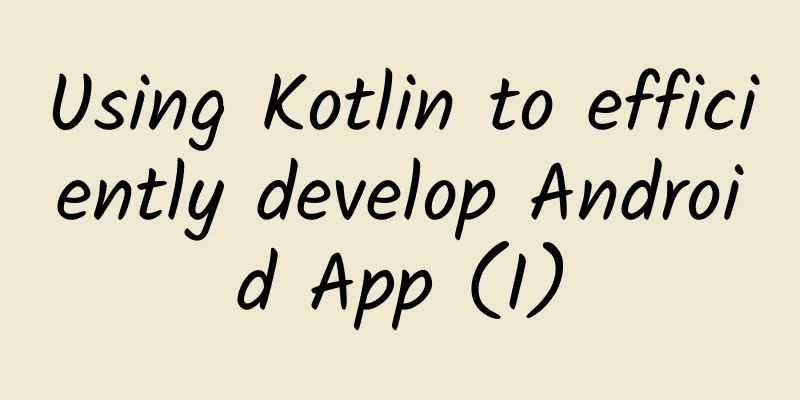Using Kotlin to efficiently develop Android App (I)

|
background Recently we are working on a blockchain-related wallet project. The new App uses a brand new technology stack. In Android, we use Kotlin+RxJava+Android Architecture Components, and in iOS, we use Swift+RxSwift. This article does not discuss the architecture of the App, but only discusses the features of Kotlin used in the project. In Android App, it is no exaggeration to say that more than 95% of our code is developed using Kotlin. Therefore, it is necessary to make a brief summary of the use of Kotlin in this stage. Kotlin features used: 1. Extension Function Kotlin allows developers to add new functions to a class without changing the existing class. This feature is called extension function. Let's take a simple example: if you want to close an I/O stream, you might write a utility method in Java.
For Kotlin, you can extend Closeable with a function closeQuietly().
After that, any class that implements the Closeable interface can use its own closeQuietly() method to close the stream. We no longer need that utility method. In the project, we use extension functions to encapsulate Glide, which greatly simplifies the use of Glide.
In addition, we use extension functions in many places. I also updated my Kolin tool library, which includes various utils and extensions. https://github.com/fengzhizi715/SAF-Kotlin-Utils 2. Trailing Closure I didn't understand this concept at first. By chance, I saw our friends write the following code when using RxBus:
I was confused at the time because I wrote RxBus and I remember that it didn't provide such a method. After clicking on the register() method, I found that register is like this:
Since Kotlin is used, the use of the register method can be simplified as follows:
Since the first parameter of register() is a method or a closure, you can move the method or closure to the outermost part. It will become what you see in the project:
This is the trailing closure, which makes the code look more concise. 3. Usage of with With is to use an object as a parameter of a function. In the function block, this can refer to the object. In the function block, you can directly call the method or property of the object.
An Adapter before using with
After using with, the function block can omit "content."
IV. Others This part is not a feature of Kotlin, but a tool I developed using Kotlin, such as the logging framework L and Retrofit's logging interceptor. These libraries were actually developed a long time ago, and their functions have been slightly upgraded recently. L's github address:
The github address of Retrofit log interceptor:
The effect diagram of the log interceptor:
Summarize Kotlin absorbs the advantages of many languages and has many exciting features compared to Java, which greatly improves development efficiency. The features introduced in this article are just a drop in the ocean. Next, I will sort out more Kotlin features used in projects. BTW, when I was writing this article, the first version of the domestic wallet had just been completed and the first round of testing began. |
>>: Make iPhone fingerprint unlocking more sensitive | Qinggong
Recommend
Community disassembly | Looking at the process from attracting new users to converting users from the perspective of game groups
What is a community? How to define community? How...
What is the total population of Guangdong in 2021? Which provinces in China have a population of over 100 million?
Guangdong is China's southern gate and is loca...
Do elephants drink snot when they drink water?
Reviewer: Chen Mingyong, Professor of the School ...
The private domain skills of urban beauties with over 200,000 followers!
Affected by the epidemic, many traditional retail...
Yu Yongfu positioned Alibaba Pictures as an industry service provider. How can the 3C-based new infrastructure empower the film industry? This made Wang Changtian questionable.
At the Shanghai International Film Festival Film I...
Different ways to implement locks in Objective-C (Part 2)
Different ways to implement locks in Objective-C ...
Earthquakes of magnitude 6.5 and 6.9 occurred for two consecutive days. Why are there so many earthquakes in Taiwan?
Since the night of September 17, Taitung County a...
How much does it cost to customize a transportation mini program in Beijing?
There is no doubt that the topic of mini programs...
Weilai's official Weibo account denies bankruptcy rumors: pure rumor
Recently, some self-media revealed that NIO is in...
The mystery of the moon's "exodus": it is moving away from the Earth at a speed of 3.8 cm per year
From the total solar eclipse On May 28, 585 BC, s...
Xigua, Huoshan, and Douyin data: daily activity, retention, and average daily usage times and duration
Everyone knows that the Internet short video fiel...
Will you gain weight easily if you wear light clothes when it’s cold?
As the weather turns cooler, it is time to prepar...
Net profit margin is falling rapidly, new technology is nowhere in sight, and CATL is in the abyss of overcapacity
On May 31, CATL, which was established only six y...
Comment weight restored? Apple has caused trouble 4 times in less than a month. Developers: exhausted!
Apple's Black Thursday Thursday is actually a...
What is the most reasonable way to eat three meals a day? Many parents have made a mistake. Be careful that the more supplements you give your children, the worse they will be.
It is summer vacation, and we are not as busy as ...









